Students can download Class 10 Science Chapter 10 Light Reflection and Refraction Important Questions, KSEEB SSLC Class 10 Science Important Questions and Answers helps you to revise the complete Karnataka State Board Syllabus and score more marks in your examinations.
Karnataka SSLC Class 10 Science Important Questions Chapter 10 Light Reflection and Refraction
Question 1.
What is light?
Answer:
Light is a form of energy. It is a form of electromagnetic radiation of a wavelength that can be detected by the human eye.
![]()
Question 2.
How do we see objects?
OR
What makes things visible?
Answer:
An object reflects light that falls on it. This reflected light, when received by our eyes, enables us to see things.
Question 3.
Give one instance front our daily life, which shows that light travels along straight lines.
Answer:
We can easily see a bright object, such as a candle flame, through a straight tube. But we cannot see the same through a bent tube. This shows that light travels along straight lines.
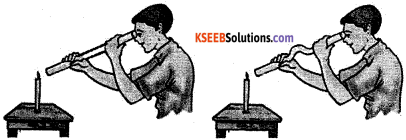
Question 4.
What is a mirror? List the various types of mirrors that you know.
Answer:
Any smooth highly polished surface that reflects most of the light that falls on it is called a mirror. There are several types of mirrors namely plane mirror, concave mirror, convex mirror, parabolic mirror and so on.
Question 5.
What are
- convergent rays
- divergent rays,
- parallel rays of light? Show them by separate diagrams.
Answer:
- Convergent rays: Light rays that are moving towards a point are called convergent rays of light.
- Divergent rays: Light rays that are emerging from a point are called divergent rays of light.
- Parallel rays: Light rays that are parallel to one another are called parallel rays of light. These rays neither diverge nor converge.
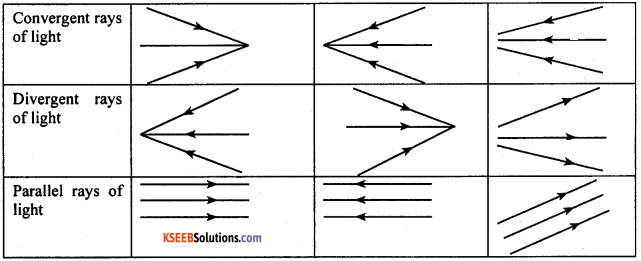
Question 6.
What is reflection of light?
Answer:
When light falls on a surface, some or most of the light is turned back from the surface. This phenomenon of bouncing back of light from a surface is called reflection.
![]()
Question 7.
Show by a suitable diagram the reflection of a light ray from a mirror. Show in the diagram the incident ray, the reflected ray, normal at the point of incidence, angle of incidence and the angle of reflection.
Answer:
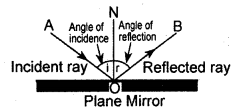
In the diagram, AO is the ray that is falling on a plane mirror. It is called the incident ray. O is the point of incidence. It is also the point of reflection. OB is the ray coming back from the mirror. It is called the reflected ray. ON is the normal drawn to the mirror at the point of incidence. ∠AON is the angle of incidence and ∠NOB is the angle of reflection.
Question 8.
Define
- angle of incidence
- angle of reflection.
Answer:
- The angle formed between the incident ray and the normal at the point of incidence is the angle of incidence.
- The angle formed between the reflected ray and the normal at the point of incidence is the angle of reflection.
Question 9.
State the laws of reflection of light.
Answer:
There are two laws of reflection of light. They are
- Angle of incidence is always equal to the angle of reflection.
- The incident ray, the reflected ray and the normal drawn to the mirror at the point of incidence all lie in the same plane.
Question 10.
For what type of surfaces do the laws of reflection apply?
Answer:
The laws of reflection are applicable to all types of surfaces including plane, concave and convex surfaces.
Question 11.
What is an image? Mention its types.
Answer:
If light rays coming from a point after reflection meet at another point or appear to meet at another point, then the second point is called the image of the first point. Images are classified into two types
- virtual image
- real image.
Question 12.
Distinguish between virtual image and real image.
Answer:
Virtual image:
- Virtual images cannot be caught on a screen.
- Virtual images are erect with respect to the object.
- Virtual images are formed by divergent rays of light.
Real image:
- Real images can be caught on a screen.
- Real images are inverted with respect to the object.
- Real images are formed by convergent rays of light.
![]()
Question 13.
List the properties of the image formed by a plane mirror.
Answer:
The images formed by a plane mirror are
- Erect and virtual. They cannot be caught on a screen.
- Equal to the size of the object.
- Formed as far behind the mirror as the object is in front of it.
- Laterally inverted.
Question 14.
What are spherical mirrors? Mention their types.
Answer:
A mirror whose reflecting surface forms a part of a sphere is called a spherical mirror. There are two types of spherical mirrors
- concave mirror
- convex mirror.
Question 15.
What is a concave mirror? How is a concave mirror represented in a diagram?
Answer:
A spherical mirror whose reflecting surface is curved inwards is called a concave mirror.
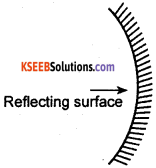
Question 16.
What is a convex mirror? How is a convex mirror represented in a diagram?
Answer:
A spherical mirror whose reflecting surface is curved outwards (bulged) is called a convex mirror.
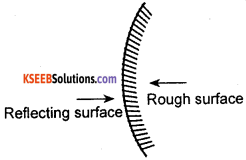
![]()
Question 17
Define the following with respect to a spherical mirror
- Pole
- Centre of curvature
- Radius of curvature
- Aperture
- Principal axis.
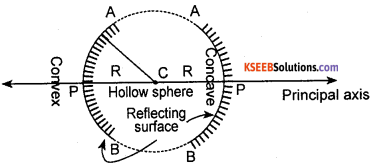
Answer:
- Pole: The centre or midpoint of the reflecting surface of a spherical mirror is called its pole. It is represented by the letter P.
- Centre of curvature: The centre of the sphere of which the given spherical mirror forms a part is called its centre of curvature. It is represented by the letter C.
- Radius of curvature: The radius of the sphere of which the given spherical mirror forms a part is called its radius of curvature. It is represented by the letter R. Thus, R = PC.
- Aperture: The diameter of the reflecting surface of a spherical mirror is called its aperture.
- Principal axis: An imaginary straight line passing through the pole (P) and centre of curvature (C) of a spherical mirror is called its principal axis.
Question 18.
What is meant by principal focus of a concave mirror? Show by a diagram.
Answer:
Principal focus of a concave mirror is defined as the point at which incident rays parallel to principal axis converge after reflection from the mirror. It is represented by the letter F.
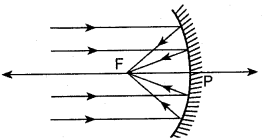
![]()
Question 19.
Why are concave mirrors called converging mirrors?
Answer:
A concave mirror redirects parallel incoming rays that fall on it and makes them meet at a point. This is why concave mirrors are called converging mirrors.
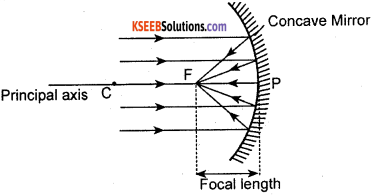
Question 20
What is meant by principal focus of a convex mirror? Show by a diagram.
Answer:
When rays of light close and parallel to the principal axis are made to fall on a convex mirror, after reflection, all the light rays appear to diverge from a fixed point on its principal axis. This point is known as the principal focus of the convex mirror. It is represented by the letter F.
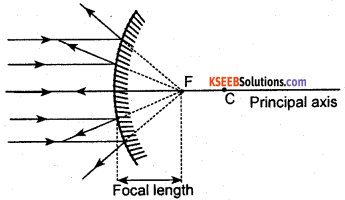
Question 21.
Why are convex mirrors called diverging mirrors?
Answer:
A convex mirror redirects parallel incoming rays that fall on it and makes them appear to diverge from a point. This is why convex mirrors are called diverging mirrors.
Question 22.
What is meant by focal length of a spherical mirror?
Answer:
The distance between the pole (P) and the principal focus (F) of a spherical mirror is called its focal length. It is represented by the letter f
Question 23.
What is the relationship between focal length and radius of curvature of a spherical mirror?
Answer:
In a spherical mirror, the principal focus (F) lies exactly at the centre of the line joining P and C.
PC = PF + FC
R = f + f = 2f
Therefore, the radius of curvature of a spherical mirror is equal to twice its focal length.
![]()
Question 24.
What is the focal length of a concave mirror whose radius of curvature is 40 cm?
Answer:
The focal length of a concave mirror is equal to half its radius of curvature.
\(f=\frac{R}{2}=\frac{40}{2}=20 \mathrm{cm}\)
Question 25.
The radius of curvature of a spherical mirror is 20 cm. What is its focal length?
Answer:
The focal length of a spherical mirror is equal to half its radius of curvature.
\(f=\frac{R}{2}=\frac{20}{2}=10 \mathrm{cm}\)
Question 26.
Find the focal length of a convex mirror whose radius of curvature is 32 cm.
Answer:
\(f=\frac{R}{2}=\frac{32}{2}=16 \mathrm{cm}\)
Question 27.
Describe an experiment to deternune the focal length of a concave mirror.
Answer:
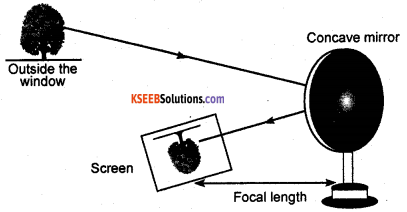
Take a concave mirror, a mirror stand, and a screen. Place the given concave mirror on the mirror stand. Direct the mirror towards a bright distant object, say, a tree. Place the screen in front of the mirror.
Move the screen back and forth until a sharp, well-defined image is formed on the screen. Measure the distance between the mirror and the screen. This distance gives the approximate focal length of the concave mirror.
Question 28.
Name a mirror that can give an erect and enlarged image of an object Where should the object be placed to get this type of image?
Answer:
A concave mirror can give an erect and enlarged image of an object. To get this type of image, the object must be placed between the pole (P) and the principal focus (F).
Question 29.
For what positions of the object does a concave mirror give a real image?
Answer:
A concave mirror gives a real image when the object is placed beyond its principal focus. The various positions of the object for which a concave mirror gives real image are:
- when the object is between F and C
- when the object is at C
- when the object is beyond C
- when the object is far beyond C.
Question 30.
For what position of the object does a concave mirror give a virtual, enlarged image?
Answer:
A concave mirror gives a virtual, enlarged image when the object is placed between P and F.
![]()
Question 31.
Where should an object be placed in front of a concave mirror to get a diminished image on a screen?
Answer:
The object should be placed beyond C of a concave mirror in order to get a diminished image on a screen.
Question 32.
For what position of the object does a concave mirror give an image equal to the size of the object?
Answer:
A concave mirror gives a real image equal to the size of the object when the object is placed at C.
Question 33.
Where should a source of light be placed in front of a concave mirror to get parallel beams of light?
Answer:
A source of light should be kept at the principal focus (F) of a concave mirror to get parallel beams of light.
Question 34.
Show by separate diagrams the reflected ray for the following incident rays in a concave mirror:
- A ray parallel to the principal axis.
- A ray passing through the principal focus.
- A ray passing through the centre of curvature, and
- A ray incident obliquely to the principal axis arid moving towards the pole.
Answer:
1. A ray parallel to the principal axis:
A ray parallel to the principal axis of a concave mirror, after reflection, will pass through the principle focus(F).
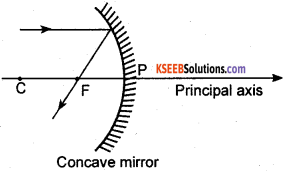
2. A ray passing through the principal focus:
A ray passing through the principal focus of a concave mirror, after reflection, will emerge parallel to the principal axis.
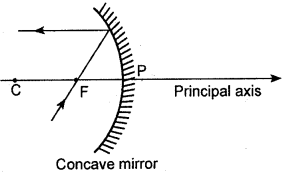
3. A ray passing through the centre of curvature:
A ray passing through the centre of curvature (C) of a concave mirror, after reflection, will get reflected back along the same path.
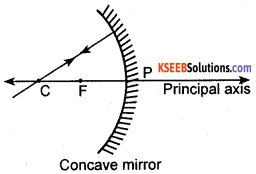
4. A ray incident obliquely to the principal axis and moving towards the pole:
A ray incident obliquely to the principal axis and moving towards the pole of a concave mirror, after reflection, will be reflected obliquely in accordance with the laws of reflection i.e., Li = Lx.
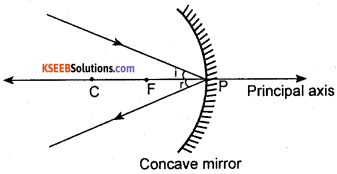
Question 35.
Explain why a ray of light passing through the centre of curvature of a concave mirror gets reflected back along the same path.
Answer:
A ray of light that is passing through the centre of curvature and incident on a concave mirror is actually travelling and striking the mirror along the normal to the surface at that point. Therefore, the angle of incidence is equal to zero and the angle of reflection is also zero. Therefore, the light ray gets reflected back along the same path.
![]()
Question 36.
Draw ray diagrams to show the image formation in a concave mirror when the object is placed
- at infinity
- beyond C
- at C
- between F and C
- at F
- between P and F.
Describe the nature, position and relative size of the image in each case.
Answer:
1. When the object is placed at infinity:
When an object is placed at infinity in front of a concave mirror, we get a real, inverted, highly diminished image at the principal focus (F).
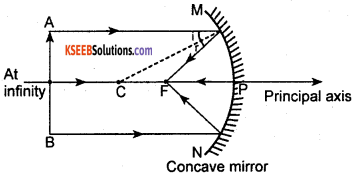
2. When the object is placed beyond C:
When an object is placed beyond the centre of curvature of a concave mirror but at finite distance, we get a real, inverted and diminished image between F and C.
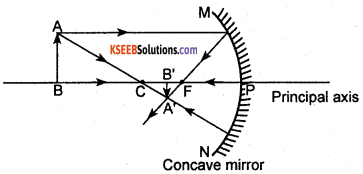
3. When the object is placed at C:
When an object is placed at the centre of curvature (C) of a concave mirror, we get a real, inverted image equal to the size of the object.
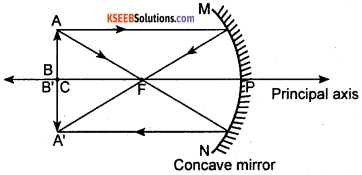
4. When the object is placed between F and C:
When an object is placed between F and C of a concave mirror, we get a real, inverted and enlarged image beyond the centre of curvature (C) of the mirror.
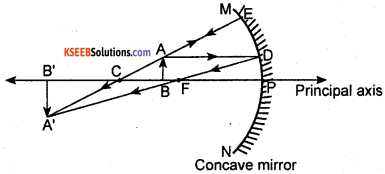
5. When the object is placed at F:
When an object is placed at the principal focus (F) of a concave mirror, we get a real, inverted and a highly enlarged image at infinity.
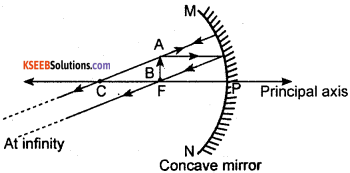
6. When the object is placed between P and F:
P and F of a concave mirror, we get a virtual, erect and enlarged image behind the mirror.
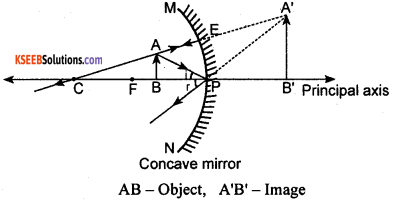
Question 37.
Mention the points with respect to a spherical mirror between which an object should be placed to obtain on a screen an image twice the size of the object
Answer:
An object must be placed at an appropriate point between F and C of a concave mirror in order to obtain on a screen an image equal to twice the size of the object.
![]()
Question 38.
List the uses of concave mirrors.
Answer:
The following are some of the uses of concave mirrors
- Concave mirrors are commonly used in torches, search-lights and vehicle headlights to get powerful parallel beams of light.
- They are often used as shaving mirrors to see a larger image of the face.
- Dentists use concave mirrors to see large images of the teeth of patients.
- Large concave mirrors are used to concentrate sunlight to produce heat in solar furnaces.
Question 39.
Show by separate diagrams the reflected ray for the following incident rays in a convex mirror:
- A ray parallel to the principal axis.
- A ray passing through the principal focus.
- A ray passing through the centre of curvature, and
- A ray incident obliquely to the principal axis and moving towards the pole.
Answer:
1. A ray parallel to the principal axis:
A ray of light parallel to the principal axis of a convex mirror, after reflection, will appear to diverge from the principal focus (F).
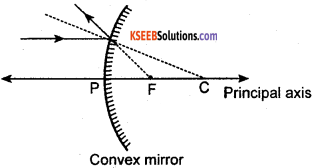
2. A ray passing through the principal focus:
A ray of light incident on a convex mirror in the direction of the principal focus (F), after reflection, will emerge parallel to the principal axis.
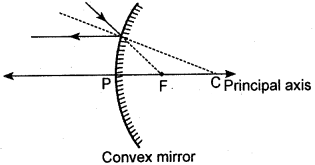
3. A ray of light passing through the centre of curvature:
A ray of light that is incident on a convex mirror in the direction of centre of curvature (C) gets reflected back along the same path.
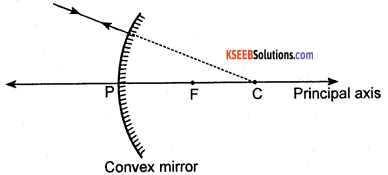
4. A ray incident obliquely to the principal axis and moving towards the pole:
A ray of light incident obliquely on a convex mirror in the direction of P, after reflection, will emerge obliquely in accordance with the laws of reflection, making equal angles with the principal axis.
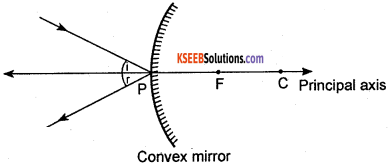
Question 40.
Draw ray diagrams to show the image formation in a convex mirror when the object is placed
- at a finite distance in front of the mirror
- at infinity.
Describe the nature, position and relative size of the image in each case.
Answer:
1. When the object is placed at a finite distance in front of the mirror:
When an object is placed at a finite distance in front of a convex mirror, we get a virtual, erect and diminished image between principal focus F and pole P behind the mirror.
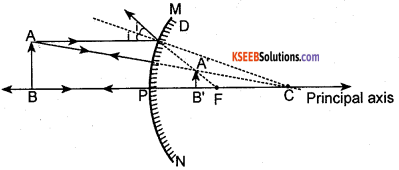
2. When the object is placed at infinity:
When an object is placed at infinity in front of a convex mirror, we get a virtual, erect and highly diminished image (point image) at its principal focus (F), behind the mirror.
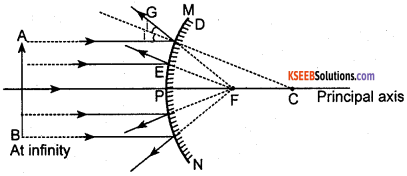
![]()
Question 41.
Summarise in a table the nature, position and relative size of the image formed by a convex mirror for various positions of the object.
Answer:

Question 42.
Listfour properties of the image formed by a convex mirror.
Answer:
The following are the properties of the image formed by a convex mirror
- Image is always virtual and erect.
- Image is always smaller than the object.
- Image is formed between P and F of the mirror.
- As we move the object away from the mirror, the image moves towards F.
Question 43.
List the uses of convex mirrors.
Answer:
The following are some of the uses of convex mirrors
- Convex mirrors are used as rear view mirrors in vehicles.
- They are used as reflector in street lamps to spread the light over a larger area.
Question 44.
Why are convex mirrors used as rear-view mirrors in vehicles?
OR
Why do we prefer a convex mirror as a rear-view mirror in vehicles?
Answer:
Convex mirrors are commonly used as rear-view mirrors in vehicles for the following reasons
- Convex mirrors always give an erect though diminished image of objects.
- Convex mirrors have a wider field of view as they are curved outwards. Therefore, convex mirrors provide the driver a view of a much larger area behind the vehicle.
- Images of nearing objects grow in size while those of receding objects diminish. These factors enable the driver to drive safely.
Question 45.
Name the type of mirror used in the following situations
- Headlights of a car.
- Side/rear-view mirror of a vehicle.
- Solar furnace.
Support your answer with reason.
Answer:
1. Concave mirror is used in the headlights of a car. This is because, a concave mirror produces a powerful parallel beam of light when the light source is placed at the principal focus.
2. Convex mirror is used in side/rear-view mirror of a vehicle. This is because, a convex mirror always gives an erect, diminished image and has a wider range of view.
3. A concave mirror is used in solar furnace. This is because, a concave mirror focuses the heat from the sun in a narrow region and thus helps to create higher temperatures.
![]()
Question 46.
You are given a plane mirror, a concave mirror and a convex mirror. How do you find out which of these can give a full length image of a tall object such as a distant tree for all positions?
Answer:
Observe the image of a distant object (say a distant tree) in a plane mirror. The full image is not seen in the mirror. When we try with plane mirrors of different sizes, the image is not seen in full. To see a full image in a plane mirror, we need a plane mirror which is at least half the size of the object. Now direct a concave mirror towards the distant tree and observe the image.
The concave mirror gives full-size image of the object only for certain positions of the object. A convex mirror, however, gives full-size image for all positions of the object. This activity shows that a plane mirror and a concave mirror cannot give full-length image for all positions of the object. A convex mirror always gives full-size image irrespective of the position of the object.
Question 47.
Compare the size of the image formed by a plane mirror, a concave mirror and a convex mirror.
Answer:
A plane mirror will always give an image equal to the size of the object. A concave mirror gives an image which is larger, smaller or equal to the size of the object depending on the position of the object. A convex mirror always gives a diminished image irrespective of the position of the object.
Question 48.
Distinguish between concave and convex mirrors.
Answer:
Concave mirror:
- The reflecting surface is curved inwards.
- Converges light rays.
- Gives either real or virtual image depending on the position of the object.
- Image may be enlarged, diminished or of same size as that of the object.
Convex mirror:
- The reflecting surface is curved outwards.
- Diverges light rays.
- Always gives virtual image irrespective of the position of the object.
- Image is always diminished irrespective of the position of the object.
Question 49.
What is meant by ‘object distance’ and ‘image distance’ with respect to a Spherical mirror?
Answer:
1. Object distance:
The distance of the object from the pole of the mirror is known as ‘object distance’. It is represented by the letter u.
2. Image distance:
The distance of the image from the pole of the mirror is known as ‘image distance’. It is represented by the letter v.
Question 50.
Write the sign conventions for reflection by spherical mirrors.
Answer:
The following are the sign conventions applicable to reflection by spherical mirrors
- All distances parallel to the principal axis are measured starting from the pole of the mirror.
- Distances measured in the direction of the incident ray are taken as positive and those measured against it are taken as negative.
- The focal length of a concave mirror is always taken to be negative and the focal length of a convex lens is always taken to be positive.
- Distances measured perpendicular to and above the principal axis are taken as positive and the distances measured perpendicular to and below the principal axis are taken as negative.
![]()
Question 51.
Write the mirror formula with respect to spherical mirrors.
Answer:
The mirror formula is \(\frac{1}{f}=\frac{1}{u}+\frac{1}{v}\)
where u = distance of the object from the pole of the mirror
v = distance of the image from the pole of the mirror
f = focal length of the mirror.
Question 52.
Define magnification with respect to spherical mirrors. Give a suitable equation for it.
Answer:
Magnification produced by a spherical mirror is defined as the ratio of the height of the image to the height of the object. It is usually represented by the letter m. If h is the height of the object and h’ is the height of the image, then the magnification m produced by a spherical mirror is given by

Question 53.
The magnification produced by a plane mirror is +1. What does this mean?
Answer:
The statement above means that the plane mirror produces an image equal to the size of the object. This means that the ratio between the height of the image and the height of the object in a plane mirror is always equal to 1. Since m is positive, the image is erect with respect to the object.
Question 54.
A convex mirror used for rear-view in an automobile has a radius of curvature of 3.00 m. If a bus is located at 5.00 m from this mirror, find the position, nature and size of the image.
Answer:
Given:
Radius of curvature, R = + 3.00 m; Object-distance, u = – 5.00 m; Image-distance, v = ?, Height of the image, h’ = ?
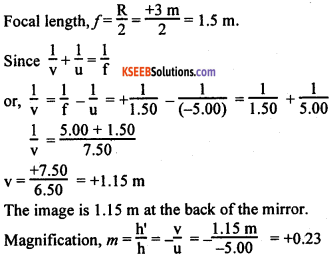
The image is virtual, erect and diminished. The size of the image is 0.23 times the size of the object.
Question 55.
‘A concave mirror of focal length ‘f conform a magnified, erect as well as an inverted image of an object placed in front of it’. Justify this statement stating the position of the object with respect to the mirror in each case for obtaining these images.
Answer:
A concave mirror of focal length/can form
- a magnified erect image when the object is placed between its pole (P) and principal focus (F)
- an inverted image of an object when the object is placed
- at F
- between F and C. Thus, the given statement is justified.
![]()
Question 56.
A concave mirror produces three times magnified (enlarged) real image of an object placed 10 cm in front of it. Where is the image located?
Answer:
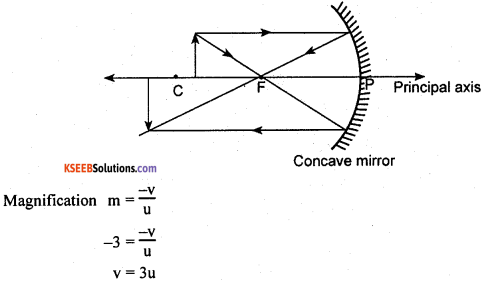
Image distance v = 3 × -10 cm = -30 cm. The image is located at a distance of 30 cm from the mirror.
Question 57.
We wish to obtain an erect image of an object, using a concave mirror of focal length 15 cm. What should be the ranee of distance of the object from the mirror? What is the nature of the image? Is the image larser or smaller than the object? Draw a ray diasram to show the image formation in this case.
Answer:
In order to obtain an erect image in a concave mirror, the object must be placed between P and F. Therefore, the range of ‘object distance’ must be 0-15 cm. The image formed is virtual and erect. The image is larger than the object. The ray diagram for getting an erect image in a concave mirror is given below
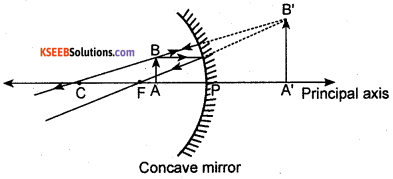
Question 58.
An object, 4.0 cm in size, is placed at 25.0 cm in front of a concave mirror of focal length 15.0 cm. At what distance from the mirror should a screen be placed in order to obtain a sharp image? Find the nature and the size of the image.
Answer:
Given: Object-size, h = +4 cm; Object-distance, u = -25 cm; Focal length, f= -15 cm; Image distance, v = ?; Image size, h’ = ?
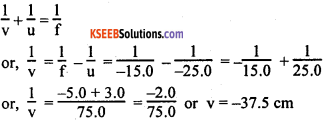
The screen should be placed at 37.5 cm from the mirror. The image is real

Height of the image, h’ = -6.0 cm. The image is inverted and enlarged. Therefore, a screen must be placed at a distance of 37.5 cm from the mirror to get a sharp image. The height of the image is 6 cm. The image is inverted and enlarged.
Question 59.
An object is placed at a distance of 10 cm from a convex mirror of focal length 15 cm. Find the position and nature of the image.
Answer:
Given
Object distance, u = -10 cm; Focal length, f = +15 cm; Image distance, v = ?
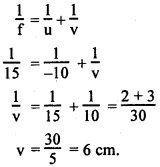
A virtual, erect and diminished image is formed 6 cm behind the mirror.
Question 60.
An object 5.0 cm in length is placed at a distance of 20 cm in front of a convex mirror of radius of curvature 30 cm. Find the position of the image, its nature and size.
Answer:
Given
Object distance, u = -20 cm; Focal length, \(f=\frac{R}{2}=\frac{30}{2}=+15 \mathrm{cm}\)
Height of the object, h – 5 cm; Image distance, v = ?
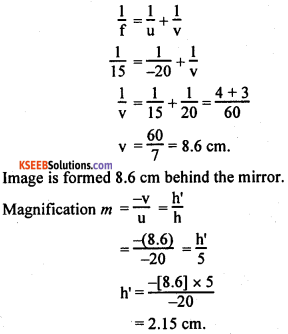
A virtual, erect and diminished image of height 2.15 cm is formed 8.6 cm behind the mirror.
![]()
Question 61.
The focal length of a converging mirror is 4 cm. If an object of height 2 cms is placed 9 cms from the mirror, find the image distance, nature and size of the image.
Answer:
Given
Object distance, u = -9 cm, Focal length, f= -4, Height of the object h = 2 cm Image distance v = ?, Height of the image h’ = ?
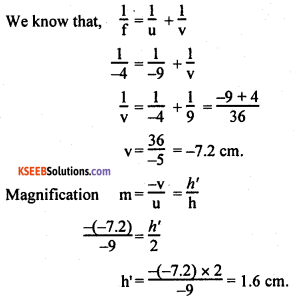
Thus, a real, inverted and diminished image of height 1.6 cm is formed at a distance of 7.2 cm between F and C.
Question 62.
An object of size 7.0 cm is placed at 27 cm in front of a concave mirror of focal length 18 cm. At what distance from the mirror should a screen be placed, so that a sharp focussed image can be obtained? Find the size and the nature of the image.
Answer:
Given
Object distance, u = -27 cm; Size of the object, h = 7 cm; Focal length, f = -18 cm; Image distance, v = ? ; Height of the image, h’ = ?
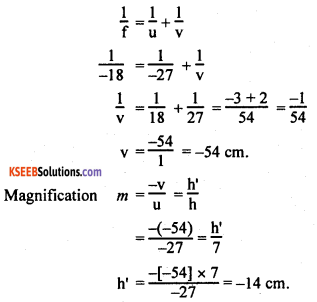
So, image is formed in front of the mirror at a distance of 54 cm from the mirror. The size of the image is 14 cm and it is real and inverted.
Question 63.
What is refraction of light?
Answer:
A ray of light that enters obliquely from one medium into another, changes its direction on entering the second medium. This phenomenon of bending of light is called refraction of light.
Question 64.
How will a ray of light that travels obliquely, bend
- when it travels from a rarer medium to a denser medium
- when it travels from a denser medium to a rarer medium?
Answer:
1. A ray of light that enters obliquely from a rarer medium to a denser medium, on entering the second medium, will bend towards the normal. In this case, the angle of refraction is smaller than the angle of incidence.

2. A ray of light that enters obliquely from a denser medium to a rarer medium, on entering the second medium, will bend away from the normal. In this case, the angle of refraction is larger than the angle of incidence.
Question 65.
When will a ray of light not change its direction despite changing the medium of propagation?
Answer:
A light that enters from one medium to another along the normal to the interface of the two media will not change its direction.
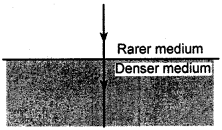
![]()
Question 66.
A ray of light travelline in air enters obliquely into water. Does the light ray bend towards the normal or away from the normal? Why?
Answer:
A ray of light that travels obliquely from air to water will bend towards the normal on entering water. This is because water is an optically denser medium than air.
Question 67.
Mention any two applications of refraction of light in daily life.
Answer:
Two instances of refraction of light in daily life are:
1. A coin placed inside a bucket filled with water appears to be raised. This is due to refraction of light. Similarly, when a thick glass slab is placed over some printed matter, the letters appear raised when viewed through the glass slab. This is due to refraction of light.
2. A pencil partially immersed in water appears bent due to refraction of light.
3. A lemon kept in water in a glass tumbler appears to be bigger than its actual size, when viewed from the sides. This is due to refraction of light.
Question 68.
Describe a simple activity to show refraction of light.
Answer:
Place a coin at the bottom of a bucket filled with water. With your eye to a side above the bucket, try to pick up the coin in one go. Try this a few times. We may not succeed in picking up the coin on most occasions.
This is because the position of the coin appears to have shifted due to refraction of light. The actual position of the coin and its apparent position are different. This is why it is difficult to pick up the coin in one swift effort.

Question 69.
Why does a pencil partially immersed in water taken in a glass tumbler appear to be bent?
Answer:
A pencil kept immersed partially in water appears bent due to refraction of light. The light coming from the part of the pencil inside water will bend away from the normal on entering air. The light reaching us from the portion of the pencil inside water seems to come from a different direction, compared to the part above water.
This makes the pencil appear to be displaced at the interface. As a result, the position of the pencil inside water appears to have shifted to a new position. This causes the pencil to appear bent.
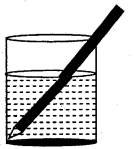
Question 70.
Why does a swimming pool appear shallower than what it actually is?
Answer:
The bottom of a swimming pool appears to be raised due to refraction of light. When light rays enter from water to air, they bend away from the normal. This causes an apparent upward shift of the bottom of the pool. This is why swimming pool appears shallower.
Question 71.
Draw a neat labelled diagram showing the path of a light ray through a rectangular glass slab.
Answer:
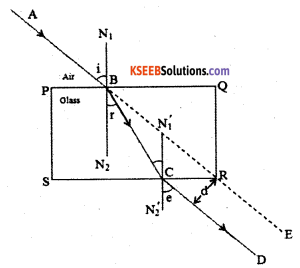
- PQRS – Rectangular glass slab
- AB – Incident ray
- BC – Refracted ray
- CD – Emergent ray
- d = Lateral shift
- N1N2 = Normal drawn to surface
- PQ N’1N’2 = Normal drawn to surface
- ∠ABN1 = i = Angle of incidence
- ∠N2BC= r = Angle of refraction
- ∠DCN’2 = e = Angle of emergence
Question 72.
Draw a neat diagram showing the path of a light ray through a parallel-sided glass slab.
Answer:
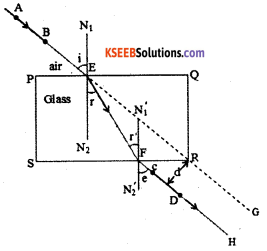
Question 73.
What is meant by lateral shift with reference to the refraction of a ray of light through a parallel-sided glass slab?
Answer:
When a ray of light is incident obliquely on a parallel-sided glass slab, the emergent ray shifts laterally. The perpendicular distance between the direction of the incident ray and the emergent ray is called‘lateral shift’.
![]()
Question 74.
What are the important characteristics you observe when a ray of light travelling obliquely enters a rectangular glass slab?
Answer:
When a ray of light travelling obliquely enters into a rectangular glass slab, the following observations are made
- The ray of light on entering from air to glass is found to bend towards the normal.
- The ray of light bends away from the normal when it enters from glass to air.
- The emergent ray gets shifted laterally. This means that the emergent ray is parallel to the direction of the incident ray.
- The angle of incidence (when the ray enters from air to glass) is equal to the angle of emergence (when the ray moves out of glass to air).
Question 75.
Why does refraction occur when a ray of light travels obliquely from one medium to another?
Answer:
Light travels at different speeds through different media. Refraction of light occurs due to the change in the speed of light as it enters from one transparent medium to another.
Question 76.
State the laws of refraction of light.
Answer:
The following are the laws of refraction of light
1. The incident ray, the refracted ray and the normal to the interface of two transparent media at the point of incidence, all lie in the same plane.
2. The ratio of sine of angle of incidence to the sine of angle of refraction is a constant, for the given pair of media and for the light of a given colour. This law is also known as Snell’s law of refraction. (This is true for angle 0 < i < 90°)
Question 77.
State Snell’s law of refraction. Express it in the form of an equation.
Answer:
Snell’s law of refraction states that ‘when a ray of light travels obliquely from one transparent medium to another, the ratio between the sine of the angle of incidence and the sine of the angle of refraction is a constant for the given pair of media for the light of a given colour.
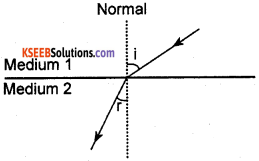
Consider a ray of light travelling obliquely from medium 1 into medium 2. Let i be the angle of incidence and r be the angle of refraction. Now, according to Snell’s law of refraction, \(\frac{\sin \mathrm{i}}{\sin \mathrm{r}}=\text { Constant }\)
Question 78.
When a ray of light travels obliquely from one medium to another, what is the ratio between sine of the angle of incidence and sine of the angle of refraction called?
Answer:
When a ray of light travels obliquely from one medium to another, the ratio between the sine of the angle of incidence and the sine of the angle of refraction is a constant and it is called the ‘refractive index’ of the second medium with respect to the first.
Question 79.
Define ‘refractive index’ of a medium. What is its symbol? Give an equation for the same.
Answer:
When a ray of light enters obliquely from one medium to another, the ratio between the sine of the angle of incidence and the sine of the angle of refraction is called the refractive index of the second medium with respect to the first. This is also called the relative refractive index of medium 2 with respect to medium 1. It is represented by the symbol n2 1.
Relative refractive index of medium 2 with respect to medium 1, n2 1\(=\frac{\sin \mathrm{i}}{\sin \mathrm{r}}=\frac{\mathrm{v}_{1}}{\mathrm{v}_{2}}\)
Similarly, refractive index of medium 1 with respect to medium 2 is denoted by n1 2\(=\frac{\text { Speed of light in medium } 2}{\text { Speed of light in medium } 1}=\frac{v_{2}}{v_{1}}\)
Question 80.
Define relative refractive index in terms of speed of light. Give an equation for the same.
Answer:
The relative refractive index of medium 2 with respect to medium 1 is defined as the ratio between the speed of light in medium 1 and the speed of light in medium 2. Let the relative refractive index of medium 2 with respect to medium 1 be n2 1\(=\frac{\text { Speed of light in medium } 1}{\text { Speed of light in medium } 2}\)
If v1 is the speed of light in medium 1 and v2 is the speed of light in medium 2, then, the refractive index of medium 2 with respect to medium 1 is given by
\(n_{2 l}=\frac{v_{1}}{v_{2}}\)
![]()
Question 81.
What does the refractive index of a medium actually indicate?
Answer:
The refractive index actually indicates the extent of the change in direction of a ray of light that takes place in a given pair of media.
Question 82.
Define absolute refractive index of a medium both in terms of Snell’s law of refraction and speed of light.
Answer:
Refractive index in terms of Snell’s law: When a ray of light enters obliquely from air into a medium, the ratio between the speed of light in air and the speed of light in the medium is called the absolute refractive index of the medium. It is represented by the symbol nm

Refractive index in terms of speed of light: The absolute refractive index of a medium is defined as the ratio between the speed of light in air (vacuum) and the speed of light in the given medium.
\(n_{m}=\frac{\text { Speed of light in air (vacuum) }}{\text { Speed of light in the medium }}\)
If va is the speed of light in air (vacuum) and vm is the speed of light in the given medium, then the absolute refractive index of the medium, nm is given as,
\(n_{m}=\frac{\mathbf{v}_{\mathbf{a}}}{\mathbf{v}_{\mathrm{m}}}\)
Question 83.
The refractive index of glass is 1.5. Explain the meaning of this statement in terms of Snell’s law.
Answer:
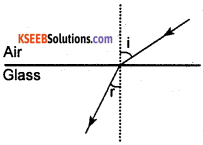
When a ray of light enters from air to glass obliquely, the ratio between the sine of angle of incidence and the sine of angle of refraction is a constant and its value is equal to 1.5. Refractive index of glass, ng is given by the equation,
\(n_{g}=\frac{\sin \mathrm{i}}{\sin \mathrm{r}}\)
Question 84.
What is the meaning of ‘the refractive index of crown glass is 1.52’?
Answer:
The refractive index of crown glass is 1.52. This means that the ratio of the speed of light in air and the speed of light in crown glass is equal to 1.52.
Question 85.
The velocity of light in water is \(\frac{3}{4} t h\) times the velocity of light in vacuum. Find the refractive index of water.
Answer:
Let the velocity of light in vacuum be x. Now the velocity of light in water is \(\frac{3 x}{4}\)

The refractive index of water is 1.33.
Question 86.
The refractive index of water is 1.33. Explain the meaning of this statement In terms of speed of light
Answer:
The statement above means that the ratio between the speed of light in air (vacuum) and the speed of light in water is 1.33.
![]()
Question 87.
The refractive index of diamond is 2.42. What is the meaning of this statement?
Answer:
This statement means that the ratio between the speed of light in air and the speed of light in diamond is equal to 2.42.
Question 88.
Light enters from air to glass having refractive index 1.50. What is the speed of light in glass? The speed of light in vacuum is 3 × 108 ms-1.
Answer:
Given
Refractive index of glass, ng= 1.5; Speed of light in vacuum, C = 3 × 108 ms-1; Speed of light in glass, vg = ?
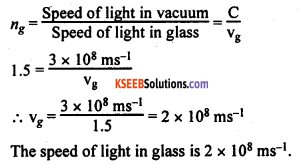
Question 89.
The velocity of light in water and kerosene is respectively 2.25 × 108 ms-1 and 2.08 × 108 ms-1. Which material has the highest refractive index? Prove your answer by calculation.
Answer:
Speed of light in water Vw = 2.25 × 108 ms-1
Speed of light in kerosene Vk = 2.08 × 108 ms-1
Refractive index of water nw = ?, Refractive index of kerosene nk = ?
Let us take the value of the speed of light in vacuum to be 108 ms-1.

The refractive index of water is 1.33.

The refractive index of kerosene is 1.44.
Question 90.
The refractive index of water, glass, diamond and alcohol are 1.33,1.5, 2.4 and 1.36 respectively. Compare the optical density of these substances. Also, find the medium with lowest optical density.
Answer:
The substances in the decreasing order of optical density are diamond, glass, alcohol and water. The substance with lowest optical density is water.
Question 91.
Find out from the table below, the medium havine highest optical density. Also find the medium with lowest optical density.
Answer:
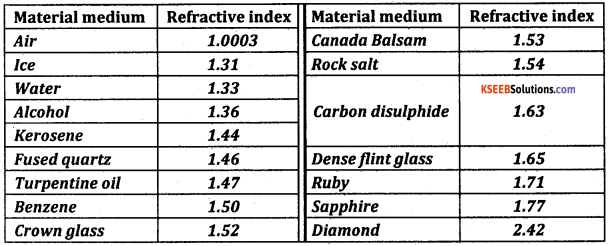
From among the substances given in the table, diamond has highest optical density while air has lowest optical density. It may be noted here that a medium with highest refractive index will have the highest optical density and vice-versa.
In the table, diamond and air have the highest and lowest refractive index respectively. Therefore, diamond has the highest optical density and air has the lowest optical density.
![]()
Question 92.
You are given kerosene, turpentine and water. In which of these does light travel fastest? The refractive index of kerosene, turpentine and water are 1.44, 1,47 and 1.33 respectively.
Answer:
The speed of light is lower in that medium which has higher refractive index. Therefore, the speed of light in water is higher than the speed of light in kerosene; the speed of light in kerosene is higher than the speed of light in turpentine. Thus the speed of light is highest in water and lowest in turpentine.
Question 93.
Refractive index of media A, B, C and D are given in the table below.
| Medium | Refractive index |
| A | 1.33 |
| B | 1.52 |
| C | 1.44 |
| D | 1.65 |
In which of these four media is the speed of light
- highest
- lowest?
Answer:
Of the given media, the refractive index of medium A has the lowest value of 1.33. Therefore, the speed of light is higher in medium A. The refractive index of medium D has the highest value of 1.65. Therefore, the speed of light is lowest in medium D.
Question 94.
What is a lens? Mention various types of lenses.
Answer:
Any transparent material bound by two surfaces, of which one or both surfaces are spherical, is called a lens. The various types of lenses are biconvex lens, biconcave lens, plano-concave lens, plano-convex lens and concavo-convex lens.

Question 95.
Which are the two major types of lenses?
Answer:
The two major types of lenses are
- convex lens
- concave lens.
Question 96.
What is a convex lens? Show by a diagram the convergence of light by a convex lens.
Answer:
A lens that is bound by two bulged spherical surfaces is called a convex lens. It is also called a converging lens. A convex lens is thicker in the middle and thinner at the edges.

Question 97.
What is a concave lens? Show by a diagram diverging action of a concave lens.
Answer:
A lens that is bound by two shallow spherical surfaces is called a concave lens. It is also called diverging lens. A concave lens is thinner in the middle and thicker at the edges.
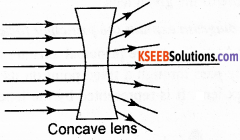
Question 98.
Define the following terms with reference to a lens
- centre of curvature
- principal axis
- optical centre
- aperture
- radius of curvature.
Answer:
1. Centre of curvature of a lens:
The centre of the sphere of which the surface of a lens forms a part is called its centre of curvature. A double convex lens and a double concave lens have two centres of curvature.

2. Principal axis of a lens:
An imaginary straight line passing through the two centres of curvature of a lens is called its principal axis.

3. Optical centre of a lens:
The geometric centre of a lens through which a ray of light passes through without undergoing any deviation is called the optical centre of the lens. It is represented by the letter O.

4. Aperture of a lens:
The diameter of the refracting surface of a lens is called its aperture.
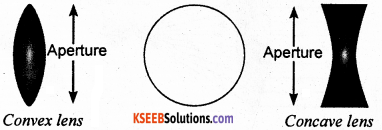
5. Radius of curvature of a lens:
The radius of the sphere of which the refracting surface of a lens forms a part is called its radius of curvature. It is the distance between the optical centre and the centre of curvature of the given lens.
![]()
Question 99.
With the help of a suitable diagram explain the principal focus of a convex lens.
Answer:
When rays of light close and parallel to the principal axis are made to fall on a convex lens, after refraction, all the light rays actually pass through a fixed point on its principal axis. This point is known as the principal focus of the convex lens. It is represented by the letter F. A double convex lens has two principal foci, one on each side.

Question 100.
How do you show that a convex lens converges light rays?
Answer:
Hold a convex lens in your hand. Direct it towards the Sun. Do not look at the sun through the lens. Focus the light from the Sun on a sheet of paper. Obtain a sharp bright image of the Sun on the paper. The rays from the sun are parallel. These parallel rays are brought to focus by the convex lens.
We get a bright tiny spot where the image of the sun is formed on the paper. Now, hold the paper and the lens in the same position -for a while. The paper begins to bum producing smoke. It may even catch fire after a while. This shows that a convex lens converges parallel rays of light.
Question 101.
With the help of a suitable diagram, explain the principal focus of a concave lens.
Answer:
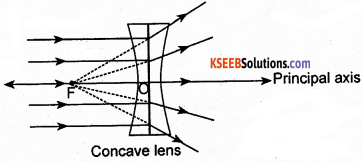
When rays of light close and parallel to the principal axis are made to fall on a concave lens, after refraction, all the light rays appear to diverge from a fixed point on its principal axis. This point is known as the principal focus of the concave lens. It is represented by the letter F. A double concave lens has two principal foci.
Question 102.
Define focal length of a lens. Show this by suitable diagram.
Answer:

The distance between the optical centre (O) and the principal focus (F) of a spherical lens is called its focal length. It is represented by the symbol f
Question 103.
Describe a simple experiment to find out the focal length of a convex lens.
Answer:
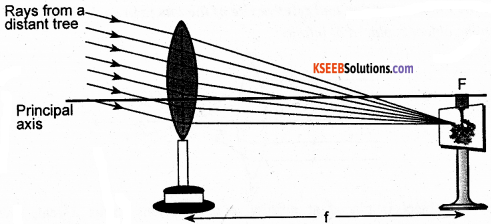
Take a convex lens, a lens stand, and a screen. Place the convex lens on the lens stand. Direct the lens towards a bright distant object, say a tree. Place the screen on the other side of the lens. Move the screen back and forth until a sharp, well-defined image of the tree is formed on the screen. Measure the distance between the lens and the screen using a scale. This distance gives the approximate focal length of the convex lens.
Question 104.
Show by separate diagrams the refracted ray in a convex lens for the following incident rays:
- A ray parallel to the principal axis.
- A ray passing through the principal focus.
- A ray incident obliquely in the direction of optical centre.
Answer:
1. A ray parallel to the principal axis:

A ray of light incident on a convex lens parallel to the principal axis, after refraction, will actually pass through the principal focus (F) on the other side of the lens.
2. A ray passing through the principal focus:

A ray of light passing through or directed to the principal focus, will emerge parallel to the principal axis.
3. A ray incident obliquely in the direction of optical centre:

A ray of light passing through the optical centre of a convex lens will emerge out without any deviation.
Question 105.
Draw ray diagrams to show the image formation by a convex lens when the. object is placed
- at infinity
- beyond 2F
- at 2F
- between F and 2F
- at F and
- between O and F.
Describe the nature, position and relative size of the image in each case.
Answer:
1. When the object is placed at infinity:
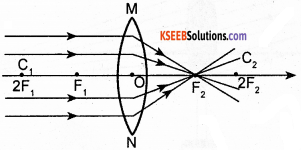
When the object is placed at infinity, a convex lens forms a real, inverted and highly diminished image at its principal focus on the other side of the lens.
2. When the object is placed beyond 2F:
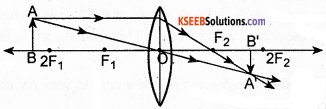
When the object is placed at finite distance beyond 2F of a convex lens, we get a real, inverted and diminished image between F and 2F on the other side of the lens.
3. When the object is placed at 2F:
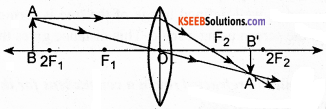
When the object is placed at 2F of a convex lens, we get a real, inverted image equal to the size of the object at 2F on the opposite side of the lens.
4. When the object is placed between F and 2F:

When the object is placed between F and 2F of a convex lens, we get a real, inverted and magnified image beyond 2F on the other side of the lens.
5. When the object is placed at the principal focus (F):

When the object is placed at the principal focus of a convex lens, a real, inverted and a highly magnified image is formed at infinity.
6. When the object is placed between optical centre (O) and principal focus (F):
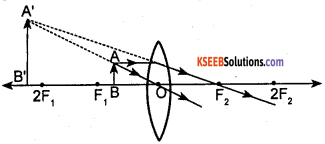
When an object is placed between O and F of a convex lens, we get a virtual, erect and magnified image on the same side of the lens as the object.
![]()
Question 106.
Show by separate diagrams, the refracted ray produced by a concave lens for the following incident rays
- A ray of light parallel to the principal axis.
- A ray of light passing through the principal focus.
- A ray of light passing through the optical centre.
Answer:
1. A ray of light parallel to the principal axis:
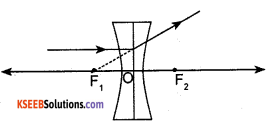
A ray of light parallel to the principal axis, after refraction from a concave lens, appears to diverge from the principal focus (F) located on the same side of the lens.
2. A ray of light passing through the principal focus:
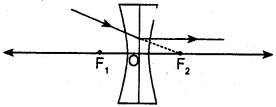
A ray of light appearing to meet at the principal focus of a concave lens, after refraction, will emerge parallel to the principal axis.
3. A ray of light passing through the optical centre:
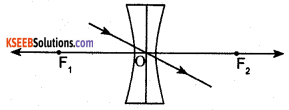
A ray of light passing through the optical centre of a concave lens, after refraction, will move without any deviation.
Question 107.
Draw ray diagrams to show the image formed by a concave lens when the object is placed
- at infinity
- at a finite distance in front of the lens.
Describe the nature, position and relative size of the image in each case.
OR
Draw ray diagrams to show the nature, position and relative size of the image formed by a concave lens
Answer:
1. When the object is placed at infinity:
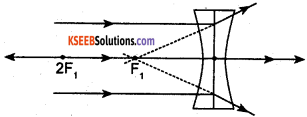
When the object is placed at infinity, a concave lens gives a virtual, erect and highly diminished image (point image) at its principal focus on the same side of the lens as object.
2. When the object is placed at a finite distance in front of the lens:
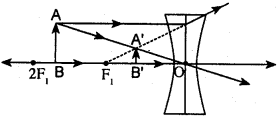
When the object is placed at a finite distance from a concave lens, we get a virtual, erect ar:’ diminished image between focus and optical centre on the same side of the lens.
Question 108.
Summarize in a table the nature, position and relative size of the image formed by concave lens for various position of the object.
Answer:

![]()
Question 109.
Distinguish between a convex lens and a concave lens.
Answer:
Convex lens:
- Converges light rays.
- Lens is thicker in the middle and thinner at the edges.
- Gives either a real image or a virtual image depending on the position of the object with respect to the lens.
- Gives either a diminished image, enlarged image or image of the same size depending on the position of the object.
Concave lens:
- Diverges light rays.
- Thinner in the middle and thicker at the edges.
- Always gives virtual image irrespective of the position of the object with respect to the lens.
- Gives only diminished image of the object irrespective of the position of the object with respect to the lens.
Question 110.
State the sign convention for lenses.
Answer:
The following sign conventions must be followed for lenses
- All distances along the principal axis must be measured from the optical centre of the lens.
- Distances measured in the direction of the incident ray are taken as positive and those measured against it are taken as negative.
- The focal length of a convex lens is taken as positive and that of a concave lens as negative.
- Distances measured perpendicular to and above the principal axis are taken as positive and distances perpendicular to and below the principal axis are taken as negative.
Question 111.
Write the lens formula and give the meaning of the symbols used.
Answer:
The lens formula is
\(\frac{1}{f}=\frac{1}{v}-\frac{1}{u}\)
where, v = distance of image from the opucal centre of lens
u = distance of object from the optical centre of lens
f = focal length of lens.
Question 112.
Define magnification produced by a tens. Give suitable equations for it.
Answer:
The magnification produced by a lens is defined as the ratio of the height of the image and the height of the object. It is represented by the letter m.
If h is the height of the object and h’ is the height of the image given by a lens, then the magnification produced by the lens is given by,
Magnification, m \(=\frac{\text { Height of the image }}{\text { Height of the object }}=\frac{h^{\prime}}{h}\)
Magnification produced by a lens is also defined as the ratio between object-distance, u and the image-distance, v. This relationship is given by
Magnification, m \(=\frac{\text { Image distance }}{\text { Object distance }}=\frac{\mathbf{v}}{\mathbf{u}}\)
![]()
Question 113.
A concave lens has focal length of 15 cm. At what distance should the object be placed from the lens so that it forms an image at 10 cm from the lens? Also, find the magnification produced by the lens.
Answer:
Given
Image distance, v = -10 cm
Focal length,f = -15 cm
Object distance, u = ?
For a lens,


Thus, the object must be placed 30 cm from the lens,

The positive sign shows that the image is erect and virtual. The image is one-third the size of the object.
Question 114.
A 2.0 cm tall object is placed perpendicular to the principal axis of a convex lens of focal length 10 cm. The distance of the object from the lens is IS cm. Find the nature, position and size of the image. Also find its magnification.
Answer:
Given
Height of the object, h = + 2.0 cm
Focal length,f = + 10 cm
Object distance, u = -15 cm
Image distance, v = ?
Height of the image, h’ = 1
For a lens,
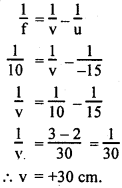
The image is formed at a distance of 30 cm on the other side of the optical centre and the image is real, inverted and enlarged.

The image is twice the size of the object.
Question 115.
A concave lens of focal length 15 cm forms an image 10 cm from the lens. How far is the object placed from the lens? Draw the ray diagram.
Answer:
Given
Focal length,f= -15 cm
Image distance, v = -10 cm
Object distance, u = ?
For a lens,

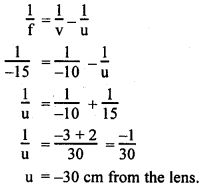
![]()
Question 116.
The focal length of a concave lens is 30 cm. At what distance should the object be placed from the lens so that it forms an image at 20 cm from the lens?
Answer:
Given
Image distance, v = -20 cm
Focal length,f= -30 cm
Object distance, u = ?
We know that for a lens,
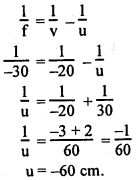
The object must be kept at a distance of 60 cm from the lens.
Question 117.
One-half of a convex lens is covered with a black paper. Will this lens produce a complete image of the object? Verify your answer experimentally. Explain your observations.
Answer:
Yes, the lens will produce a complete image. Even if half of the convex lens is covered with black paper, the lens will produce a complete image. However, the intensity of the image gets reduced. This can be verified experimentally by using a lighted candle and a convex lens.
Take a lighted candle and place it in front of a convex lens mounted on a stand. Move the candle back and forth to obtain the full image on the screen. Once the full image is observed, mark the position of the candle. Now cover the lower half of the lens with a black opaque paper. Do not change the position of the candle.
Now, we observe a full image of the candle, but the intensity is reduced. This is because the covered part of the lens does not allow light to pass through it. So the amount of light reaching the screen is reduced.
Question 118.
An object 5 cm in length is held 25 cm away from a conversine lens of focal length 10 cm. Draw the ray diagram and find the position, size and the nature of the image formed. Also find the height of the image.
Answer:
Given
Object size, h’ = 5 cm
Object distance, u = -25 cm
Focal length of the lens,f= 10 cm
Image distance, v = ?
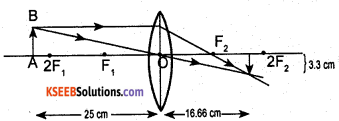
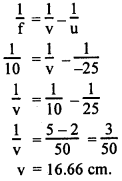
A real image is formed on the other side of the lens at 16.66 cm.
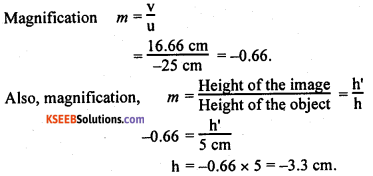
A real, inverted and diminished image 3.3 cm tall is formed below the principal axis.
Question 119.
What is meant by power of a lens? Mention its S.I. unit
Answer:
The degree of convergence or divergence of light rays achieved by a lens is expressed in terms of its power. The power of a lens is defined as the reciprocal of its focal length, when focal length is expressed in metre.
\(Power (P)=\frac{1}{\text { focal length (in metre) }}=\frac{1}{f}\)
The S.I. unit of power of a lens is called ‘dioptre’ (D).
Question 120.
Define 1 dioptre of power of a lens.
Answer:
1 dioptre is the power of a lens whose focal length is 1 metre.
Question 121.
What is the meaning of “The power of a lens is 1 dioptre”?
Answer:
One dioptre is the power of a lens whose focal length is 1 metre.
Question 122.
Find the power of a concave lens of focal length 2 m.
Answer:
\(\text { Power }=\frac{1}{f}=\frac{1}{-2 m}=-0.5 D\)
![]()
Question 123.
A convex lens forms a real and inverted image of a needle at a distance of SO cm from it. Where is the needle placed in front of the convex lens if the image is equal to the size of the object? Also, find the power of the lens.
Answer:
Given
Image distance, v = 50 cm
Magnification, m = 1
Object distance, u = ?

The needle is placed 50 cm from the lens.
Focal length of the convex lens \(f=\frac{50}{2}=25 \mathrm{cm}=0.25 \mathrm{m}\)
Power of the lens \(P=\frac{1}{f}=\frac{1}{0.25 m}=+4 D\)
Question 124.
Find the focal length of a lens of power -2.0 D. What type of lens is this?
OR
If the power of a lens is -2.0 D, then what type of lens is it?
Answer:

Since f is negative, the lens is concave.
Question 125.
A doctor has prescribed a corrective lens of power +1.5 D. Find the focal length of the lens. Is the prescribed lens diverging or conversine?
Answer:

Since power is positive, lens is converging or convex
Question 126.
Name the type of mirror that always produces virtual image. Mention one use of this mirror.
Answer:
A concave lens always gives a virtual image. Concave lens is used to correct myopia.
Question 127.
An object is kept at a distance of 20 cm from a lens of power +5 D. State the nature, position and relative size of the image formed in this situation. Draw a suitable ray diagram for this.
Answer:
Focal length (in metre), \(f=\frac{1}{\text { Power }}=\frac{1}{+5 D}=+0.2 \mathrm{m} .=+20 \mathrm{cm}\)
This is a convex lens of focal length 20 cm. The object is kept at F. Therefore, a real, inverted and highly enlarged image is formed at infinity. The ray diagram for this is given below
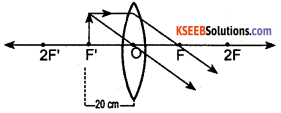
Question 128.
The object distance of a lens is -30 cm and image distance is -10 cm. Find the magnification of the lens. With the help of this, decide whether the size of the image is smaller or bigger than the size of the object
Answer:
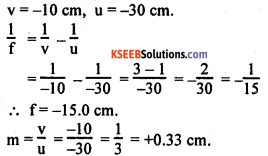
Fill In The Blanks
1. A lens that converges light rays is convex lens
2. The centre of the reflecting surface of a spherical mirror is called pole
3. The radius of curvature of a spherical mirror of focal length 20 cm is 40 cm
4. The magnification in a plane mirror is always equal to 1
5. The mirror used as rear-view mirror in vehicles is convex mirror
6. The reciprocal of the focal length of a lens is called its power
7. According to Snell’s law, the ratio between sine of the angle of incidence and the sine of the angle of refraction is always constant
8. The centre of the sphere of which the refracting surface of a lens forms a part is called its centre of curvature
![]()
Multiple Choice Questions
Question 1.
Which one of the following materials cannot be used to make a lens?
(A) Water
(B) Glass
(C) Plastic
(D) Clay
Answer:
(D) Clay
Question 2.
The image formed by a concave mirror is observed to be virtual, erect and larger than the object. Where should the position of the object be?
(A) Between the principal focus and the centre of curvature
(B) At the centre of curvature
(C) Beyond the centre of curvature
(D) Between the pole of the mirror and its principal focus.
Answer:
(D) Between the pole of the mirror and its principal focus.
Question 3.
Where should an object be placed in front of a convex lens to get a real image of the size of the object?
(A) At the principal focus of the lens
(B) At twice the focal length
(C) Between the optical centre of the lens and its principal focus.
(D) At infinity
Answer:
(B) At twice the focal length
Question 4.
A spherical mirror and a thin spherical lens have each a focal length of-15 cm. The mirror and the lens are likely to be
(A) both concave.
(B) both convex.
(C) the mirror is concave and the lens is convex.
(D) the mirror is convex, but the lens is concave.
Answer:
(A) both concave.
Question 5.
No matter how far you standfrom a mirror, your image appears erect. The mirror is likely to be
(A) plane.
(B) concave.
(C) convex.
(D) either plane or convex.
Answer:
(D) either plane or convex.
Question 6.
The image formed by a plane mirror is always
(A) virtual and erect
(B) real and erect
(C) real and inverted
(D) virtual and inverted
Answer:
(A) virtual and erect
Question 7.
A concave mirror gives a real, inverted image equal to the size of the object when the object is placed
(A) at F
(B) at infinity
(C) at C
(D) beyond C
Answer:
(C) at C
Question 8.
If the power of a lens is -40 D, its focal length is
(A) 4 m
(B) -40 m
(C) -0.25 m
(D) -0.025 m
Answer:
(D) -0.025 m
Question 9.
QuestA concave mirror gives a virtual, erect and enlarged image of the object when the object is
(A) at infinity
(B) between F and C
(C) between P and F
(D) beyond C
Answer:
(C) between P and F
Question 10.
In optics, an object which has higher refractive index, is called
(A) optically denser
(B) optically rarer
(C) optical density
(D) refractive index
Answer:
(A) optically denser
Question 11.
The optical phenomena, twinkling of stars, is due to
(A) Atmospheric reflection
(B) Atmospheric refraction
(C) Total reflection
(D) Total refraction
Answer:
(B) Atmospheric refraction
Question 12.
Convex lens gives a real, point sized image at the principal focus when the object is placed
(A) at 2F
(B) at focus
(C) at infinity
(D) between F and 2F
Answer:
(C) at infinity
Question 13.
The unit of power of lens is
(A) Metre
(B) Centimetre
(C) Dioptre
(D) joule per second
Answer:
(C) Dioptre
Question 14.
The radius of curvature of a mirror is 20 cm. The focal length is
(A) 10 cm
(B)20cm
(C).40cm
(D) 5 cm
Answer:
(A) 10 cm
Question 15.
The rear view mirror in motor vehicles is a
(A) plane mirror
(B) convex mirror
(C) concave mirror
(D) convex lens.
Answer:
(B) convex mirror
![]()
Question 16.
A concave mirror forms a magnified inverted image when the object is placed at
(A) F
(B) C
(C) beyond C
(D) between F and C
Answer:
(D) between F and C
Question 17.
The laws of reflection hold good for
(A) plane mirrors only
(B) convex mirrors only
(C) concave mirrors only
(D) all types of mirrors
Answer:
(D) all types of mirrors
Question 18.
The mirror formula for a spherical mirror is
(A) \(\frac{1}{f}=\frac{1}{u}+\frac{1}{v}\)
(B) \(\frac{1}{f}=\frac{1}{2 u}+\frac{1}{v}\)
(C) \(\frac{1}{f}=\frac{1}{u}-\frac{1}{v}\)
(D) \(\frac{1}{f}=\frac{1}{u}+\frac{1}{2 v}\)
Answer:
(A) \(\frac{1}{f}=\frac{1}{u}+\frac{1}{v}\)
Question 19.
Negative value offocal length of a spherical mirror indicates that it is
(A) concave mirror
(B) convex mirror
(C) plane mirror
(D) convex mirror of small focal length
Answer:
(A) concave mirror
Question 20.
A convex mirror always gives
(A) a real, inverted, enlarged image of the object
(B) a real, diminished, erect image of the object
(C) a virtual, erect, diminished image of the object
(D) a virtual, inverted, enlarged image of the object.
Answer:
(C) a virtual, erect, diminished image of the object
![]()
Question 21.
On a new stainless steel spoon, one can see the image of one’s face upside down. The part of the spoon acts like a
(A) convex lens
(B) concave mirror
(C) convex mirror
(D) concave lens
Answer:
(B) concave mirror
Question 22.
According to Cartesian Sign Convention,
(A) object distance is always negative.
(B) object distance is always positive
(C) image distance is always negative.
(D) image distance is always positive.
Answer:
(A) object distance is always negative.
Question 23.
Power of a lens is
(A) equal to its focal length
(B) reciprocal of the focal length (in metres)
(C) square of its focal length (in metres)
(D) reciprocal of its radius of curvature.
Answer:
(B) reciprocal of the focal length (in metres)
Question 24.
An object placed between F and 2F of a convex lens will produce
(A) a virtual image
(B) a diminished image
(C) a real and inverted image
(D) an erect image
Answer:
(C) a real and inverted image
Question 25.
Lens formula is expressed as
(A) \(\frac{1}{v}-\frac{1}{u}=\frac{1}{f}\)
(B) \(\frac{1}{v}+\frac{1}{u}=\frac{1}{f}\)
(C) \(\frac{1}{u}-\frac{1}{v}=\frac{1}{f}\)
(D) u + v = f
Answer:
(A) \(\frac{1}{v}-\frac{1}{u}=\frac{1}{f}\)
![]()
Question 26.
Magnitude of magnification less than 1 indicates that the
(A) size of image > size of object
(B) size of image = size of object
(C) size of image < size of object
(D) size of image is independent of size of object.
Answer:
(C) size of image < size of object Question
27. According to the law of refraction (Snell’s law),
(A) \(\frac{\sin \mathrm{i}}{\sin \mathrm{r}}=\mathrm{constant}\)
(B) angle i = angle r
(C) sin i = sin r
(D) sin i > sin r
Answer:
(A) \(\frac{\sin \mathrm{i}}{\sin \mathrm{r}}=\mathrm{constant}\)
Question 28.
Which of the following lenses would you prefer to use while reading small letters found in a dictionary?
(A) A convex lens of focal length 50 cm.
(B) A concave lens of focal length 50 cm.
(C) A convex lens of focal length 5 cm.
(D) A concave lens of focal length 5 cm.
Answer:
(C) A convex lens of focal length 5 cm.
Question 29.
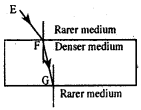
Observe the figure above. The correct figure indicating the direction of the light ray FG after refraction is
(A) 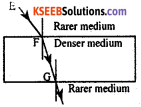
(B) 
(C) 
(D) 
Answer:
(D)

Match The Following
| Column A | Column B |
| Position of the object with respect to a convex lens | Position of the image |
| 1. Between O and F | (a) At F |
| 2. At F | (b) At 2F |
| 3. Between F and 2F | (c) Between F and 2F |
| 4. At 2F | (d) Beyond 2F |
| 5. Beyond 2F | (e) Same side of lens as objec |
| (f) At infinity -c. |
Answer:
1 – e, 2 – f, 3 – d, 4 – b, 5 – c.
| Column A | Column B |
| Position of the object with respect to a concave mirror | Properties of the image |
| 1. Between P and F | (a) Real and same size as the object |
| 2. At F | (b) Virtual and enlarged |
| 3. Between C and F | (c) Real and highly enlarged |
| 4. At C | (d) Real and enlarge |
| 5. Beyond C | (e) Real and point sized |
| 6. At infinity | (f) Real and diminished |
| (g) Real point image – f, 6 – e. |
Answer:
1 – b, 2 – c, 3 – d, 4 – a, 5 – f, 6 – e.